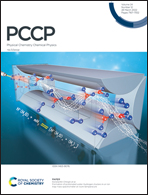Two-dimensional square and hexagonal oxide quasicrystal approximants in SrTiO3 films grown on Pt(111)/Al2O3(0001)†
Abstract
The formation of two-dimensional oxide dodecagonal quasicrystals as well as related complex approximant phases was recently reported in thin films derived from BaTiO3 or SrTiO3 perovskites deposited on (111)-oriented Pt single crystals. Here, we use an all-thin-film approach in which the single crystal is replaced by a 10 nm thick Pt(111) buffer layer grown by molecular beam epitaxy on an Al2O3(0001) substrate. An ultra-thin film of SrTiO3 was subsequently deposited by pulsed laser deposition. The film stacking and structure are fully characterized by diffraction and microscopy techniques. We report the discovery of two new complex phases obtained by reduction of this system through high temperature annealing under ultrahigh vacuum conditions. The formation of a new large square approximant with a lattice parameter equal to 44.4 Å is evidenced by low-energy electron diffraction and scanning tunneling microscopy (STM). Additionally, a new 2D hexagonal approximant phase with a lattice parameter of 28 Å has been observed depending on the preparation conditions. Both phases can be described by two different tilings constructed with the same basic square, triangle and rhombus tiles possessing a common edge length of about 6.7 Å. Using the tiling built from high resolution STM images, we propose an atomic model for each approximant which accounts for the experimental observations. Indeed, the STM images simulated using these models are found to be in excellent agreement with the experimental ones, the bright protrusions being attributed to the topmost Sr atoms. In addition our theoretical approach shows that the adhesion of the oxide layer is rather strong (−0.30 eV Å−2). This is attributed to charge transfer, from the most electropositive elements (Sr and Ti) to the most electronegative ones (Pt and O), and to hybridization with Pt-states. Density of states calculations indicate differences in the electronic structure of the two approximants, suggesting different chemical and physical properties. This all-thin-film approach may be useful to explore the formation of complex two-dimensional oxide phases in other metal-oxide combinations.

- This article is part of the themed collection: 2022 PCCP HOT Articles


 Please wait while we load your content...
Please wait while we load your content...